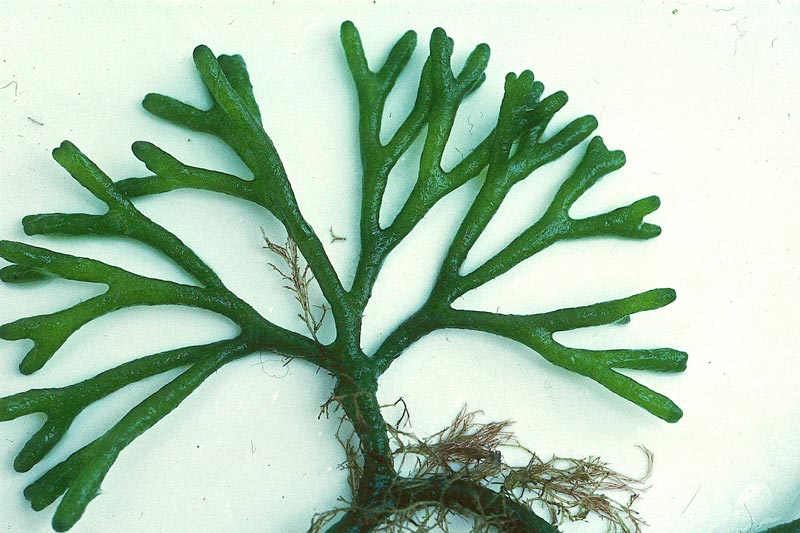Codiums: Edible around the world
Oceanographers like to call Codium a minor seaweed because it is not commercially exploitable. Yet where it is found around the world it is eaten. It is also considered one of the most invasive species in the world. So, there’s food near you.
One species, Codium fragile ssp. tomentosoides, was first reported in Holland in 1900. In the century since it has spread throughout Europe. It’s now found along the shores of Britain, Australia, New Zealand, the Mediterranean and North America It was first reported in North American in 1957 on Long Island,
Many Codium species are fleshy and have a soft texture. This leads to such common names such as “sponge weed” “rats’ feet” or “dead man’s fingers.” They are found often in the the intertidal zone on rocky shores but are also common on beaches and around found around Florida and the Gulf Coast. Raw Codium has an earthy flavor, much like oysters, and is full of vitamins and fatty acids. It sells for about $7 a pound, wet.
In the Hawaiians Islands Codium, after being throughly washed, is eaten raw, often with tomatoes. It is never cooked or blanched because it becomes soft and disintegrates from the heat. In Japan it is preserved in salt.
The Codiums include C. muelleri, C. tenue, C. formosanum, C. intricatum, and C. papillatum. Pictured are C. reediae, C. fragile, C. isthmocladium, C. edule, C., tomentosum, and C. decorticatum.
Codium is the favorite food of some sea slugs, snails and sea urchins. It is often found on beaches after a storm still attached to little pebbles or shells and some think that is how some beaches get the pebbles and shell build up.
Codium Salad
4 cups Codium, well cleaned
1 small sweet onion
1 medium tomato
1/4 cup soy sauce
2 teaspoons wine vinegar
2 teaspoons sugar
1/4 cup sherry
1 teaspoon black pepper
Mix dressing ingredients and pour over chopped onions. Just before serving, chop the tomatoes and Codium and toss with dressing. Garnish with slices of tomato. Chill and serve.
Green Deane’s “Itemized” Plant Profile
IDENTIFICATION: Codium is pale to dark green or olive green, very bush-like appearance, with many branches arising from a disk shaped holdfast. Branches are cylindrical, resembling fingers. When submerged, Codium branches feel soft and “fuzzy” When washed up on beaches and or during the winter hairs are lost and the branches become coarse. Codiums can grow up to four feet and can wash up on beaches as a whole plant or in small pieces, particularly after storms.
TIME OF YEAR: Year round, grows in spring and fall
ENVIRONMENT: Two feet to 200 feet, in northern climates in tidal polls near low tide, southern water on reefs, washed up on shore.
METHOD OF PREPARATION: Usually raw, wash well and check local news for any harmful algae blooms. If cooked it disintegrates. Can be preserved in salt.



I have been harvesting codium from our shores here in Harwich, MA. Red River Beach for an addition to my garden compost for about ten years. Recently I purchased some worms to incorporate into my compost bin. I fear the codium has killed the worms because of the salt content in the codium even though I rinsed it. Your comment please. Thank you, Joe Doran
Joe, it’s very possible even after rinsing most algae still have significant internal salt content due to osmoregulation. Is your compost covered or open to the rain. I think after several heavy rain events some of the salt may be leached enough for worm survival but it’s hard to say. Your best bet might just be to spread most of the compost on your garden and start over without using supplemental algae.
Good luck
P.S. Great article, I love codium and have been eating it for years.
Thank you Clayton. I just now rediscovered your entry. I have stopped using the codium and apparently did not destroy all my worms because their numbers have increased quite a bit. In an adverturous moment, I may very well try that salad. ” well cleaned” needs some elaboration though.
And then on to the bane of my existence, hairy bittercress. Are you familiar with the beast?
In your experience, is their any health risk in eating this? By washing do you simple mean rinsing in fresh water?
I’d found Codium in the mediterranean coast and I eat it before to know that it was edible, leaving it in water 1 night. I am still here. However I’d also cooked it: fried after covering with bread powder. Ciao Franco
Few days ago, in plain winter, I’d gone in the same place I’d used to find Codium. No plants !!!! Does’it day in the winter ?
Thanks. Franco Paolinelli